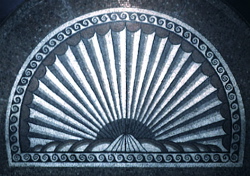Difference between revisions of "Art"
(New page: '''The Arts''' is a broad subdivision of culture, composed of many expressive disciplines. In modern usage, it is a term broader than "art", which usually means the visual arts (comprising...) |
|||
| Line 1: | Line 1: | ||
| + | [[Image:lighterstill.jpg]] | ||
| + | [[Image:Mosaicshell.jpg|right|"Mosaic Shell"]] | ||
| + | |||
'''The Arts''' is a broad subdivision of culture, composed of many expressive disciplines. In modern usage, it is a term broader than "art", which usually means the visual arts (comprising both [[fine art]], [[decorative art]], and [[crafts]]). The arts encompasses [[visual arts]], [[performing arts]], [[language arts]], and [[culinary arts]]. Many artistic disciplines involve aspects of the various arts, so the definitions of these terms overlap to some degree. To access contents of '''The Arts''' see:[http://www.revisionscontrol.com/wiki/index.php/Category:The_Arts] | '''The Arts''' is a broad subdivision of culture, composed of many expressive disciplines. In modern usage, it is a term broader than "art", which usually means the visual arts (comprising both [[fine art]], [[decorative art]], and [[crafts]]). The arts encompasses [[visual arts]], [[performing arts]], [[language arts]], and [[culinary arts]]. Many artistic disciplines involve aspects of the various arts, so the definitions of these terms overlap to some degree. To access contents of '''The Arts''' see:[http://www.revisionscontrol.com/wiki/index.php/Category:The_Arts] | ||
---- | ---- | ||
| − | |||
'''History''' | '''History''' | ||
---- | ---- | ||
| − | |||
| − | |||
Quatrain on Heavenly Mountain by Emperor Gaozong (1107–1187) of Song Dynasty | Quatrain on Heavenly Mountain by Emperor Gaozong (1107–1187) of Song Dynasty | ||
The great traditions in art have a foundation in the art of one of six ancient civilizations: | The great traditions in art have a foundation in the art of one of six ancient civilizations: | ||
| − | * Mesopotamia, | + | * [[Mesopotamia]], [[Egypt]], [[India]], [[China]], [[Greece]], and [[Rome]] |
| − | |||
| − | |||
| − | |||
| − | |||
| − | |||
Ancient Greek art saw a veneration of the human form and the development of equivalent skills to show musculature, poise, beauty and anatomically correct proportions. Ancient Roman art depicted gods as idealized humans, shown with characteristic distinguishing features (i.e. Zeus' thunderbolt). | Ancient Greek art saw a veneration of the human form and the development of equivalent skills to show musculature, poise, beauty and anatomically correct proportions. Ancient Roman art depicted gods as idealized humans, shown with characteristic distinguishing features (i.e. Zeus' thunderbolt). | ||
| Line 63: | Line 58: | ||
Newspapers such as the New York Times and The Times of London typically include a section on the arts.[http://en.wikipedia.org/wiki/The_Arts] | Newspapers such as the New York Times and The Times of London typically include a section on the arts.[http://en.wikipedia.org/wiki/The_Arts] | ||
| + | |||
| + | [[Category: General Reference]] | ||
| + | [[Category: The Arts]] | ||
Revision as of 21:29, 15 December 2007
The Arts is a broad subdivision of culture, composed of many expressive disciplines. In modern usage, it is a term broader than "art", which usually means the visual arts (comprising both fine art, decorative art, and crafts). The arts encompasses visual arts, performing arts, language arts, and culinary arts. Many artistic disciplines involve aspects of the various arts, so the definitions of these terms overlap to some degree. To access contents of The Arts see:[1]
History
Quatrain on Heavenly Mountain by Emperor Gaozong (1107–1187) of Song Dynasty
The great traditions in art have a foundation in the art of one of six ancient civilizations:
Ancient Greek art saw a veneration of the human form and the development of equivalent skills to show musculature, poise, beauty and anatomically correct proportions. Ancient Roman art depicted gods as idealized humans, shown with characteristic distinguishing features (i.e. Zeus' thunderbolt).
In Byzantine and Gothic art of the Middle Ages, the dominance of the church insisted on the expression of biblical and not material truths.
Eastern art has generally worked in a style akin to Western medieval art, namely a concentration on surface patterning and local colour (meaning the plain colour of an object, such as basic red for a red robe, rather than the modulations of that colour brought about by light, shade and reflection). A characteristic of this style is that the local colour is often defined by an outline (a contemporary equivalent is the cartoon). This is evident in, for example, the art of India, Tibet and Japan. An artist's palette An artist's palette
Religious Islamic art forbids iconography, and expresses religious ideas through geometry instead.
The physical and rational certainties depicted by the 19th-century Enlightenment were shattered not only by new discoveries of relativity by Einstein [1] and of unseen psychology by Freud, [2] but also by unprecedented technological development.
Increasing global interaction during this time saw an equivalent influence of other cultures into Western art.
The various arts
A precise definition of the arts can be contentious, but the following areas of activity usually are included:
- Architecture
- Art & Visual arts
- Crafts
- Dance
- Decorative art
- Design
- Drawing
- Fashion
- Film
- Language
- Literature
- Music
- Opera
- Painting
- Photography
- Poetry
- Sculpture
- Theatre & Performing arts
- Ikebana
- Video
Historically, the arts included the Artes Liberales (liberal arts) taught in medieval universities as part of the Trivium (grammar, rhetoric, and logic) and the Quadrivium (arithmetic, geometry, music, and astronomy.)
In modern academia, the arts are usually grouped with or a subset of the Humanities. Some subjects in the Humanities are history, linguistics, literature, philosophy, women's studies.
Newspapers such as the New York Times and The Times of London typically include a section on the arts.[2]
